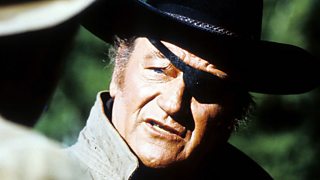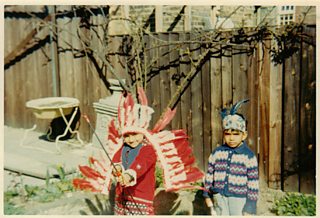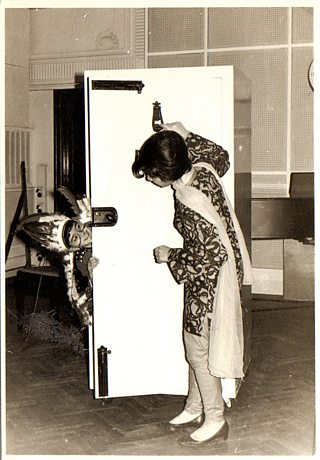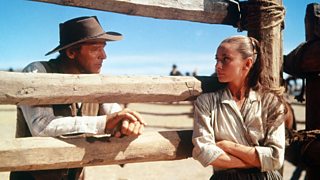How The West Was Fun: When Britain loved cowboys
Samira Ahmed
Broadcaster
Listen to Archive on 4: Riding into Town from Saturday 6 April at 8.00pm.

John Wayne
I was probably of the last generation to grow up with the Western (Quentin Tarantino is another) and I was aided by a brother a few years older. He once spent an entire week on holiday in Italy in the mid 70s, walking around with his eyes screwed up trying to look like Clint Eastwood in The Good, The Bad and The Ugly. But where he loved the spaghetti Western spawned in the 60s, I preferred the old Hollywood westerns of the 50s. Only people who've never watched proper Westerns really think they're all about celebrating macho men brutalizing native Americans. Many are doing the opposite; tackling racism, injustice and lynch mobs, sometimes covertly, but often openly.

For my Archive on Four: Riding Into Town I explore the decades from the 30s to the 70s when Westerns ruled in Britain and why they were such a loved form of escapism. Look carefully at pop culture of the 60s and you'll notice The Shadows playing Apache and The Beatles dressing up in stetsons and cowboy boots. I talked to fans of all kinds. Christopher Frayling, a world authority on the spaghetti western, outlined the history of the British gentleman in westerns – The Sheriff of Fractured Jaw, A Man Called Horse, Shalako and also Savage Guns, a Hammer Film, which he thinks was the first spaghetti western. He explained how the violent nihilism of the European spaghetti Western grew out of the counterculture of the 60s.

I found myself singing the Marilyn Monroe theme tune to River of No Return with Richard Holloway, the former Bishop of Edinburgh, who grew up obsessed with the cowboy films and serials, which he watched in the Saturday morning cinema clubs of the 1940s. His favourite, Shane (1953) features a Messianic hero, and inspired Holloway to become a priest. In the original Jack Schaefer novella, Shane is described as a "good man with a good tool", embodying the modern difficulty we have in watching the Western, especially as we see the ongoing battle for gun control in the US.
I found that it was often women, like Holloway's mother, who chose the family's cinema outings and they chose westerns. Women often had leading roles in the 40s and early fifties – Barbara Stanwyck, Joan Crawford and Marlene Dietrich feature in some of the greatest.

The Unforgiven, featuring Burt Lancaster and Audrey Hepburn
In the documentary you can also hear film historian Stephen McVeigh at Swansea University and me deconstructing the delights of gender and sexuality in some cult Westerns that feature in the list below. He told me his students usually claim to hate the genre, but often change their mind after watching one of his recommendations. He also thinks the Western successfully endures in different forms, such as Star Wars and the cartoon film Rango. In many ways science fiction and fantasy have replaced the Western landscape as the dreamworld where anything is possible.
Some of the most serious Western enthusiasts now are re-enactors too, such as The Lawmen who I met in Bristol. Priding themselves on authenticity, they research and "inhabit" real Western characters such as Annie Oakley and Doc Holliday and love the more recent Westerns such as Tombstone and Unforgiven, which get the details of clothing and equipment right.
Caroline Lawrence, the bestselling children's author of the Roman Mysteries grew up obsessed with Westerns. I talked to her about the challenge of writing Westerns for children – the first of her PK Pinkerton Western Mysteries begins quite uncompromisingly with a scalping. It is strange to think that modern children know more about ancient Egypt or Rome than the Wild West. Of course it's in our hands to change that.
Richard Holloway, the former Bishop of Edinburgh, discusses watching Westerns in the 1940s
Here's my personal top ten of subversive or cult Westerns to try out for yourself:
Rancho Notorious (1952) Fritz Lang (best known for Metropolis) creates the Expressionist western. The hero seeks out the man who murdered his fiancée and finds his way to Marlene Dietrich's strange ranch where she is Queen of a motley brood of outlaws. Hate, murder, revenge are all the more powerful in the artifice of its sets.
Johnny Guitar (1954) Weird wonderful, and very camp. Two powerful women, often dressed in male garb, battle it out over land and love. Joan Crawford's showdowns with Mercedes McCambridge leaves the men as mere onlookers. Don't be fooled by the title. The eponymous Johnny knows better than to interfere. Director Nicolas Ray lights it with the dreamlike intensity of Rebel Without A Cause.
The Searchers (1958) Often rated the greatest Western ever but it's far more than it seems. John Wayne's Ethan is on a quest to find his niece kidnapped by Comanches, but he is no loveable hero. There is darkness at his core and an unsettling racism in his motivation. The moral heart of the film is his companion, the part-Indian Martin Pawley (Jeffrey Hunter), who pulls Ethan back from the final kill. Susan Faludi's excellent book about 9/11 "The Terror Dream" takes its title from a line in the original Alan LeMay novel and explains how the Western still powers a delusional American male identity today.
Saddle The Wind (1958) written by Rod "The Twilight Zone" Serling this tale of rival brothers is a fascinating clash of acting eras and cultures. Robert Taylor is the old, Romantic Hollywood confronted by the Method acting frenzy of his trigger-happy younger brother John Cassavetes. Singer Julie London (a great Western actress) is always mesmerizing.
Flaming Star (1960) Originally written for Marlon Brando, Elvis Presley is the brooding half-Kiowa son enraged by the cruel racism inflicted on his mixed race family. Dolores Del Rio is his mother, in a fine and inspiring female role. This was directed by Don Siegel (future collaborator with Clint Eastwood) who focuses on the inescapable momentum of violence.
The Unforgiven (1960) This is like a mirror image of The Searchers and based on a novel by the same writer, Alan LeMay. In this case Audrey Hepburn is the allegedly kidnapped Indian girl the Kiowa want back. While one brother stays loyal (Burt Lancaster) another Audie Murphy (in true life America's most famous and decorated WWII soldier) turns against her in an act of horrifying racism. Silent age star Lillian Gish is a noble and brave matriarch. A wonderful film.
The Singer Not The Song (1961) British and unintentionally gay, but then what did you expect with Dirk Bogarde as a Mexican bandit wearing his own custom-made black leather trousers, gloves and hat? There is, in theory, a female love interest, but it's all about Bogarde's obsession with John Mills's Catholic priest. The orgasmic end in which they fall into eachother's arms in a hail of bullets has to be seen to be believed.
The Beguiled (1971) Don Siegel again with a truly Gothic Western. Clint Eastwood – a wounded Union soldier finds himself the cockerel in the henhouse when he takes refuge in a Southern finishing school for young ladies, but things take a sinister turn. A Stephen King-like macho nightmare in the age of women's lib, apparently this is one of Eastwood's favourite films.
Back To the Future III (1990) A perfect introduction to the Western for children. Full of affection for the genre, with a genuine villain, jokes about the prissy tassled cowboy costumes of the 50s, a strong female (Mary Steenburgen's schoolteacher) and an early burst of steampunk in Doc's re-booted time machine.
The Quick and The Dead (1995) Sam Raimi's film has virtually the same plot as the sombre Unforgiven (1992) and even the same villain – Gene Hackman - but is a lot more fun and self-aware. Sharon Stone is the mysterious stranger who comes to town to take part in a gunfighting contest. Leonardo Di Caprio and a very young Russell Crowe provide the sex appeal. Film historian Stephen McVeigh pointed out that Stone is only ever vulnerable and makes mistakes when dressed as a woman.
Listen to Archive on 4: Riding into Town from Saturday 6 April at 8.00pm.
Visit Samira Ahmed's site or follow her on Twitter
The BBC is not responsible for the content of external websites.
